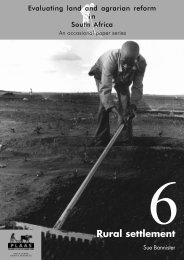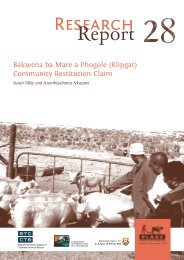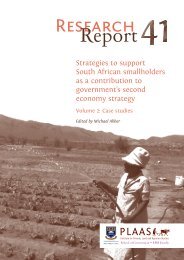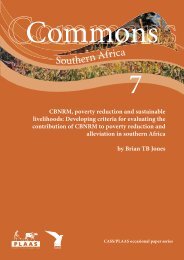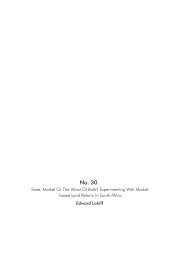A critical appraisal of South Africa's market-based land reform policy
A critical appraisal of South Africa's market-based land reform policy
A critical appraisal of South Africa's market-based land reform policy
You also want an ePaper? Increase the reach of your titles
YUMPU automatically turns print PDFs into web optimized ePapers that Google loves.
Chapter 6: LRAD projects in Limpopo<br />
cattle farming. Bellevue was a state farm,<br />
like the Steilloop and Manamead farms,<br />
and Mr Kutumela has been leasing it for<br />
about six years after it was made available<br />
by the DoA.<br />
Mr Kutumela applied for the LRAD<br />
grant in 2002 after hearing about it at the<br />
Zebediela Farmers’ Union meeting. He did<br />
not remember how long the application<br />
process took, but it was not long, ‘just a<br />
few months’ (interview 16). Strangely<br />
DLA does not have the project listed as<br />
approved, so the project is not included in<br />
the statistics given for approved projects in<br />
Chapter 5 above. The researchers were<br />
referred to Mr Kutumela by the DLA<br />
Project Officer responsible for that district.<br />
Mr Kutumela believed his project had been<br />
approved during 2002.<br />
The farm is approximately 1 450ha <strong>of</strong><br />
<strong>land</strong> paid for by an LRAD grant and Mr<br />
Kutumela’s own cash contribution that<br />
came from his pension payout when he<br />
retired as a policeman. He now works fulltime<br />
on the farm. He employs seven<br />
workers, three women and four men, and<br />
his son is also assisting him with the<br />
farming. The main activity on the farm<br />
is cattle farming and there are currently<br />
120 cattle. There are also some sheep and<br />
goats. The relatively large number <strong>of</strong><br />
employees are required to assist in clearing<br />
the <strong>land</strong> <strong>of</strong> dense thorny bush that<br />
negatively affects the grazing capacity.<br />
Project design and <strong>land</strong><br />
acquisition<br />
Contrary to the LRAD <strong>policy</strong> that envisages<br />
a ‘demand directed’ process (DLA 2001:6)<br />
most <strong>of</strong> the projects in this study were<br />
initiated by DLA and DoA because they<br />
are on what was state <strong>land</strong> and the decision<br />
had been taken to dispose <strong>of</strong> that <strong>land</strong><br />
through LRAD. This approach raises<br />
another question about the extent to which<br />
such <strong>land</strong> transfers are addressing the<br />
racial inequality in <strong>land</strong> access in <strong>South</strong><br />
Africa. LRAD sets as a primary objective<br />
the redistribution to ‘black people’ <strong>of</strong> 30%<br />
<strong>of</strong> ‘white commercial farm<strong>land</strong>’(DLA<br />
2001:6) yet only the <strong>land</strong> acquired for the<br />
Vele and Mankweng Integrated projects<br />
fits that description.<br />
Despite not significantly contributing<br />
to <strong>land</strong> redistribution, the LRAD projects<br />
implemented in Limpopo may have value<br />
as tenure upgrading projects. The beneficiaries<br />
have certainly benefited in terms<br />
<strong>of</strong> being assisted to purchase <strong>land</strong> at very<br />
preferential rates. For example Mr Netshilema<br />
(interview 6) at Manamead had to<br />
pay just R8 000 for his 373ha farm. His<br />
existing assets were considered to be his<br />
contribution to the project and calculated<br />
to be <strong>of</strong> sufficient value for him to get the<br />
maximum grant <strong>of</strong> R100 000. Calculated<br />
at a production value <strong>of</strong> R231 per hectare,<br />
the total <strong>land</strong> price was R108 000. The<br />
R8 000 was paid with a Land Bank loan<br />
organised by DLA. Six <strong>of</strong> the beneficiaries<br />
at Manamead are becoming owners <strong>of</strong><br />
farms ranging from 139–256ha without<br />
having to borrow or contribute any money<br />
themselves. The beneficiaries interviewed<br />
also appreciated that they were able to<br />
acquire <strong>land</strong> without being required to<br />
have their own finance or collateral.<br />
Worryingly, a number <strong>of</strong> the respondents<br />
at Manamead did not know the value<br />
<strong>of</strong> the <strong>land</strong> they had received, the size <strong>of</strong><br />
the grants they are purported to have received,<br />
or the amount <strong>of</strong> their own contribution<br />
to the projects. This is probably due<br />
to the way the projects were initiated and<br />
administered entirely by DLA and further<br />
illustrates a lack <strong>of</strong> ‘ownership’ <strong>of</strong> the<br />
process by the beneficiaries. Beneficiaries<br />
<strong>of</strong> the Mankweng Integrated project made<br />
‘own contributions’ in the form <strong>of</strong> labour,<br />
valued at R5 000 per person, and the entire<br />
<strong>land</strong> cost was covered by the grant. In the<br />
Vaalkop project the <strong>land</strong> was donated and<br />
the beneficiaries were allocated grants <strong>of</strong><br />
R20 000 each <strong>based</strong> on their own<br />
contribution <strong>of</strong> R5 000 each in the form<br />
<strong>of</strong> labour. At Steilloop the beneficiaries<br />
acquired much larger farms and had to<br />
borrow substantial amounts <strong>of</strong> money,<br />
from R219 000–R335 000, to cover the<br />
cost <strong>of</strong> the <strong>land</strong> purchased. A number <strong>of</strong><br />
the respondents complained about the<br />
difficulty <strong>of</strong> paying <strong>of</strong>f these loans.<br />
35







